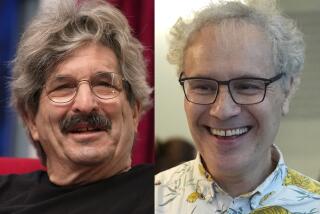Two Europeans Win Nobel Prize in Physics
- Share via
The effect is called giant magnetoresistance, but it enables amazing things at the miniature level. Two European scientists won the 2007 Nobel Prize in physics Tuesday for their discoveries of the phenomenon, which spurred some of computing’s most astonishing developments, from video-playing handheld devices to PCs whose storage capacity now seems all but limitless.
France’s Albert Fert and Germany’s Peter Gruenberg independently described giant magnetoresistance in 1988, then saw the electronics industry apply it in disks with incredible amounts of storage.
“I can hardly think of an application that has a bigger bang than the magnetic hard drive industry,” said Phil Schewe, a physicist and spokesman for the American Institute of Physics. “Every one of us probably owns three or four or five devices, probably more, that depend on billions of bits of information stored on something the size of a dime.”
Fert, 69, is scientific director of the Mixed Unit for Physics at CNRS/Thales in Orsay, France, while Gruenberg, 68, is a professor at the Institute of Solid State Research in Juelich, Germany. They will share the $1.5 million prize.
Gruenberg told reporters he was not too surprised to win the Nobel. “Because I have received a lot of awards, I was often asked, `When will the big award come?’” Gruenberg said.
Asked if he’d thought his discovery would have such wide application, Fert told The Associated Press: “You can never predict in physics. ... These days when I go to my grocer and see him type on a computer, I say, `Wow, he’s using something I put together in my mind.’ It’s wonderful.”
Here’s how it works.
As a metal disk spins inside a hard drive, an arm with a sensitive electromagnetic head at its tip hovers over the disk, somewhat like the needle on a record player (though it doesn’t make contact). This head reads bits of data by registering the magnetic bearing of individual particles; it writes data by changing that magnetic orientation.
For disk drives to increase in capacity, those magnetic particles must become smaller, so more can be packed into the same amount of space. But these ever-tinier materials produce fainter magnetic signals, which means the read-write head in the disk drive has to become more sensitive.
What Fert and Gruenberg independently discovered was that extremely thin layers of alternating metals could detect remarkably weak changes in magnetism -- and translate them into “giant” changes in electrical resistance.
In other words, the particles used in data storage could get much denser and still produce the electrical signals that computers read as ones or zeros as they do their business.
It took until 1997 for giant magnetoresistance (GMR) to get translated from Fert and Gruenberg’s raw science into a product for the disk market. That was led by IBM Corp., where researcher Stuart Parkin developed a way to incorporate Fert and Gruenberg’s findings into the cost-effective manufacturing process already used to produce disk drives.
One result can be measured in disk-drive density -- the number of bits that can be squeezed into a given area. In the 1990s, disk density was generally improving about 60 percent a year. But GMR sparked a few years in which density doubled -- a 100 percent rise -- and costs still fell.
The steep ramp explains how today’s top iPods pack more storage than desktop computers of just a few years ago. (For instance, Apple Inc. offers a 160-gigabyte iPod -- 10 times the capacity of IBM’s first GMR drive for PCs a decade ago.)
GMR also helped herald the promise of nanotechnology in computing, said John Best, chief technologist for Hitachi Ltd.’s data-storage unit.
“It showed you could do really interesting things on a nanoscale,” he said. “That wasn’t so clear.”
GMR does not deserve sole credit for recent improvements in data storage. For one thing, it’s not used in solid-state “flash” memory that has less capacity than hard drives. Fert joked about that in an interview Tuesday, when he said his iPod, loaded with jazz, was busted.
“It’s my fault because I got an iPod with a GMR hard drive,” he said. “If I had an iPod with a simple flash memory, it wouldn’t be broken.”
Yet physicists say the full influence of what Fert and Gruenberg began is still to be felt.
That’s because the surprising property of giant magnetoresistance is one of many “quantum effects” that crop up when atoms are confined to really small spaces. Researchers are beginning to master methods for manipulating and measuring these other factors as well, which could prompt still more sophisticated ways of cramming data into minuscule spaces.
The field is known as “spintronics” because it harnesses the electromagnetic property of electrons known as spin.
“What we’re discovering with spintronics, compared with GMR,” said Mark Dean, director of IBM’s Almaden Research Center in San Jose, Calif., “is like comparing silicon to the vacuum tube.”
* __
Associated Press Writers Malcolm Ritter in New York, Jamey Keaten in Paris, Erich Reimann in Juelich, and Matt Moore and Karl Ritter in Stockholm, Sweden, contributed to this report.
* __
On the Net:
Nobel physics page: https://tinyurl.com/ytkk7k
More to Read
Sign up for Essential California
The most important California stories and recommendations in your inbox every morning.
You may occasionally receive promotional content from the Los Angeles Times.











